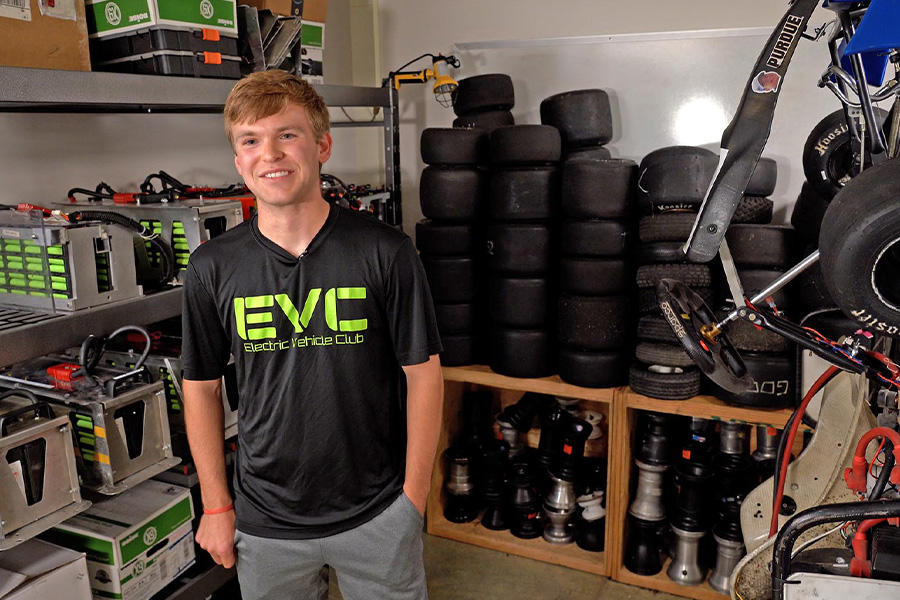Purdue's Electric Vehicle Club turns battery power into horsepower
At most motorsports events, earplugs are an absolute necessity to dampen the massive roar of internal combustion engines. But attend the evGrandPrix, and you’ll only hear two sounds: students cheering, and dozens of electric race cars zooming past at 50 miles an hour – with all the sound and fury of an electric toothbrush.
These lightning-fast whirs represent a lot of very clever engineering. Purdue’s Electric Vehicle Club (EVC) specializes in creating these electric vehicles, and they recently shared the challenges of turning the quietest car into the fastest car.
Purdue created the evGrandPrix in 2010 as a companion race to the traditional Purdue Grand Prix, the go-kart race that has been held annually on campus since 1958. Like the Purdue Grand Prix, any student group can build and race an evGrandPrix kart. But electric karts present a much bigger challenge.
“The biggest difference between a combustion car and an electric car is the drivetrain,” said Matthew Kane, president of EVC and a senior in electrical engineering. “All of your energy must be delivered from a battery to a motorized drivetrain. To do that, you need a massive battery pack.”
EVC’s self-built battery packs feature arrays of lithium-ion batteries – which also require arrays of safeguards. “In that one-and-a-half cubic feet, you’ve got more than 4.2 kilowatt-hours of energy, ready to be released,” said Matthew. “There are entire pages of the rulebook related to battery management systems, technical inspections, and safety.”

But when those watts turn into horsepower, the effect is astonishing. “When you put the pedal down, you’ve got all the torque right there immediately,” said Matthew. “We can accelerate up to 50 miles an hour in just seconds.”
To regulate that power, evGrandPrix applies a unique constraint: no more than 14 kilowatts can ever leave the battery at any point in time. Each cart has a power energy monitor attached to its battery, recording those vital stats to an SD card during the race. After the race, technical inspectors upload that data into a spreadsheet to ensure that the respective carts stayed under that limit for the whole race.
“evGrandPrix is scored in three ways,” said Matthew. “First is where you placed in the race. Second is a design report you submit ahead of time about your kart. And third is energy efficiency. So a big chunk of winning the championship is designing a torque curve that will get the most out of the power at the right times, while staying under that 14 kilowatt limit. And then a lot of it comes down to driver skill. If our driver can apply the right amount of power and avoid tapping the brakes as much as possible, that will put us ahead even though all karts are running at the same power.”
Putting this all together requires students from many different disciplines. EVC currently has students from at least 15 different majors. “We obviously need mechanically-minded students to build and maintain the kart itself,” said Matthew, “but electrical and computer engineers are also vital, because we have a lot of high power electronics here. When you’re pushing 300 amps through these wires, we need people who know what they’re doing and can troubleshoot problems.”
But Matthew adds that business majors, liberal arts majors, and many others also find their place promoting and managing the club. “I found EVC as a freshman, because it gave me the opportunity to get involved immediately,” he said. “Our karts are objectively simpler than some of the other vehicles on campus, so even if you have very little engineering or motorsports experience, you can jump right in to a wiring diagram, or a wheel assembly. And it’s not just competitive go-karts; we’re also building electric motorcycles, longboards, and lots of other unique projects. You can be hands-on from day one.”
Motorsports also sets students up for future careers. The Purdue Motorsports website is full of stories from Purdue students who succeeded in motorsports, as well as other industries beyond. One prominent example is EVC alum Tony “Danger” Coiro, who is now working at SpaceX as the director of manufacturing for their Raptor engines.
“Ten years ago, he was right here, working on electric go-karts,” said Matthew. “It just shows you where motorsports can take you in the future.”
Source: Purdue's Electric Vehicle Club turns battery power into horsepower
